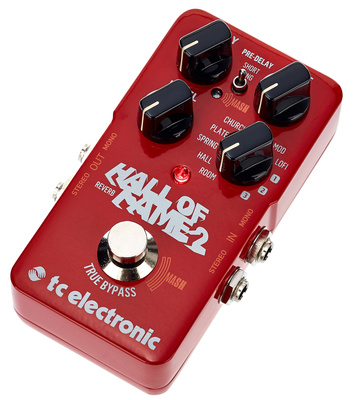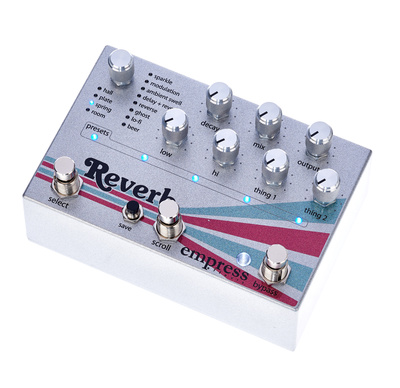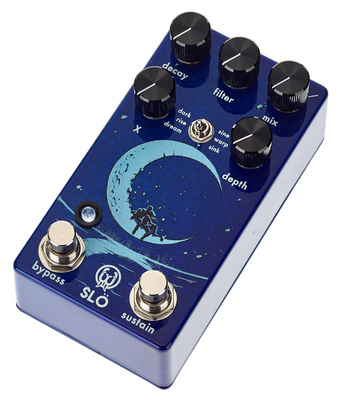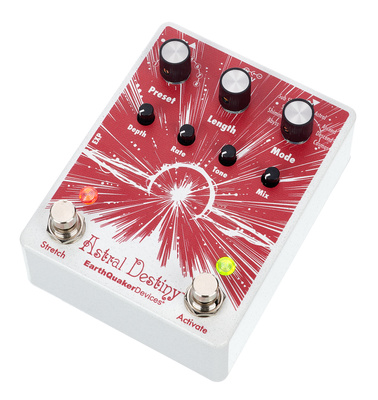The five best reverb effects
Reverb effects are an absolute classic on any guitarist's pedalboard. In this article, we'll explain exactly what reverb is and introduce you to our five favourite reverb pedals.
What is a reverb effect?
Reverb means 'echo' in English, which pretty much describes what you can expect from this effect. Reverb effects are now an integral part of almost every song and have become indispensable in the music world. Therefore, a good reverb effect should not be missing from your setup.
Reverb effects are so popular because they add spatiality to your guitar sound, making it much more epic. Depending on the type of reverb and the settings on the pedal, you can make your guitar sound as if it is playing in a large concert hall, a church, or even a stalactite cave. With the right reverb pedals, you can also make your guitar sound as if it's playing in an underwater landscape or outer space.
How do reverb effects work?
They simulate how your guitar would sound in a different environment. For example, let's say you were playing in an open field. In this case, your audience would only hear the sound coming directly from you.
If you played in a closed room, however, your listeners would hear not only your direct sound, but also the sound that bounced off the surrounding walls. This sound is then reflected by the walls, changing the sound and causing it to arrive at the listener with a delay.
The greater the delay, the larger the acoustic space appears. If you play in your bedroom, for example, the sound travels such a short distance that there is hardly any audible reverb, as the delay is simply not long enough. In a concert hall or church, of course, the situation is completely different.
Reverb effect pedals add these otherwise non-existent reflections to your 'dry' sound. You can then use the knobs on the effect pedal to adjust parameters such as the size of the room.
What types of reverb effect are there?
Not all reverbs are the same. Below, we explain some of the most common categories of reverb that you will encounter time and again in effect pedals.
Analogue reverb: The first reverb devices operated mechanically or analogously. Examples include plate reverb, where metal plates vibrate to create the reverb, and reverb spirals, which work in a similar way but require significantly less space. Nowadays, of course, there are digital simulations of all the most common analogue reverb effects.
Acoustic reverb: Acoustic reverb simply uses a physical space with the required sound characteristics. In this case, you play in a room that generates its own reverb. However, this is not practical for most guitarists and is rarely used today. Nevertheless, many digital reverb effects are based on terms that originated in this category. These include:
Room: A small room, such as a bedroom or living room.
Chamber: A sound chamber used in recording studios.
Hall: A concert hall.
Cathedral: A large church or cathedral.
Digital reverb: Most reverb effects today fall into this category. However, many digital reverb effects are still based on their analogue or acoustic predecessors and therefore have names such as 'plate', 'spring', 'room' or 'hall'.
What's the difference between reverb and delay?
These effects are very similar in concept and are therefore often confused with each other. They both change the sound spatially. However, these effects still sound very different.
As mentioned above, reverb is a hall effect. It makes your sound sound as if it were being reflected by walls at varying distances. This creates an illusion of width and spaciousness. This effect gives your music room to breathe, so to speak. Thanks to the hall effect, your guitar will sound fuller, and your sound will be less choppy and dry.
Delay, on the other hand, simply means delay. The idea is that your guitar signal is played back with a time delay. In principle, this is a simulated echo. The main difference between delay and reverb is that with delay, you can hear the echo, whereas with reverb, it is more diffuse.
Here are the five best reverb pedals
These five reverb effect pedals are our current favourites. It's not easy to narrow down the large number of available reverbs to such a small selection. There are many good reverb pedals out there. In this case, we have taken care to list pedals from different categories. Therefore, these are not necessarily the best-sounding reverb effects in absolute terms.
TC Electronic Hall of Fame 2
The Hall of Fame 2 is featured on virtually every list of the best reverb effects. We have to agree with this positive assessment. For around £120, the Hall of Fame 2 offers a lot.
Firstly, the sound quality is impressive. The range of effects is also impressive. The Hall of Fame 2 features a rotary control for room size with eight preset settings. There are also three memory slots for your own creations, which can be filled via the app.
The device has a foot switch called MASH with several pressure levels that allow you to mix in the right amount of reverb. The Hall of Fame 2 also supports true bypass.
In our opinion, the Hall of Fame offers excellent value for money and is suitable for ambitious beginners and advanced players alike.
Strymon blueSky
With a price tag of just over £300, the Strymon blueSky prioritises quality over quantity. Although it offers only three reverb types, they all sound absolutely fantastic. These can be further specialised using three modes.
As well as the decay and mix knobs, the blueSky has a pre-delay knob and a damp equaliser with separate treble and bass controls. A footswitch allows you to save your settings to a favourite slot or activate bypass mode.
The blueSky is ideal for advanced users and professionals who want high-quality reverb without any unnecessary extras.
Empress Effects Reverb
With a price tag of €450–€500, the Empress Effects Reverb is clearly aimed at professionals. But for that money, you get a device with outstanding-sounding reverb effects that can be adjusted in a variety of ways – and there are plenty of them.
As well as the standard decay and mix knobs, the pedal has two equaliser controls for treble and bass. The effects range from reverb and ambient swell to lo-fi. The Empress pedal offers a total of 32 different algorithms. You can also save your settings in 35 preset memory locations.
As with all devices from this brand, the Empress Effects reverb pedal is a professional-grade product with, in our opinion, uncompromisingly good sound quality.
Walrus Audio Slö Multi Texture Reverb
Do you prefer dark or dreamy soundscapes? If so, the Walrus Audio Slö is just what you need. This reverb pedal has three effect types:
Dark: a long, dark reverb with an additional low octave.
Rise: a swelling reverb.
Dream: A reverb with an added vibrato effect.
Like the Hall of Fame 2, the Slö supports true bypass. This Walrus Audio device offers plenty of adjustment options, including five rotary controls, a toggle switch and two footswitches. With a price tag of around £170, the Slö is not the cheapest device, but we believe it is well worth the money.
The Walrus Audio Slö is ideal for experienced players who enjoy playing dark or atmospheric music.
EarthQuaker Devices Astral Destiny
The name says it all with the Astral Destiny from EarthQuaker Devices. Priced at around £170, this is not a generalist reverb pedal; it specialises in creating crazy shimmer sounds. Instead, it specialises in creating crazy shimmer sounds with names like 'Abyss', 'Astral', 'Ascend' and 'Cosmos'.
It's not just the unusual, high-quality sounds that make this pedal special. Designed by Marvel comic artist Matt Horak, it also looks really stylish. Another interesting feature is the stretch footswitch, which doubles the reverb length and adds an adjustable pitch shift.
The Astral Destiny is ideal for advanced guitarists who enjoy playing mysterious and atmospheric music.
Conclusion
As we wrote in our effects pedal guide, we believe that a reverb effect is essential for every guitarist. So, if you're a beginner, you should invest in a suitable pedal right from the start. However, even advanced players and professionals may find it worthwhile to upgrade to a better device.
We hope that this article has given beginners and advanced players alike some ideas about which reverb pedal might be right for them.




